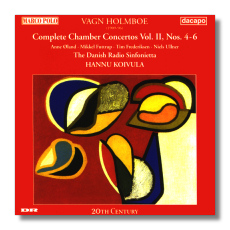
The Internet's Premier Classical Music Source
Related Links
- Latest Reviews
- More Reviews
-
By Composer
-
Collections
DVD & Blu-ray
Books
Concert Reviews
Articles/Interviews
Software
Audio
Search Amazon
Recommended Links
Site News
 CD Review
CD Review
Vagn Holmboe

Chamber Concertos
- Concerto #4 for Piano Trio & Chamber Orchestra Op. 30
- Concerto #5 for Viola & Chamber Orchestra Op. 31
- Concerto #6 for Violin & Chamber Orchestra Op. 33
Anne Oland, piano
Mikkel Futtrup, violin
Tim Frederiksen, viola
Niels Ullner, cello
The Danish Radio Sinfonietta/Hannu Koivula
Marco Polo dacapo 8.224063 DDD Total time 62:00
The Danish composer Vagn Holmboe (1909-1996) studied in Copenhagen and Berlin and learned Balkan folk music during travels in Transylvania. He uses central European folk material in an unusual synthesis with contemporaneous Scandinavian styles. The result is neither here nor there, tending to combine the weaker elements of both. These concertos, written between 1942 and 1945, are a not entirely successful combination of the harmonies of Nielsen or Sibelius with the insistent rhythms and ad hoc organisation of the folk music.
Holmboe's opus 30 opens with unison strings and an initial melodic figure that takes some unexpected turns. It is at least lively, and the material gradually converges toward something like a conventional tune. The opening unison returns at the end, another conventional touch. This is followed by an elegiaque Andante "un poco tranquillo" and a spirited finale which sounds very much like the opening Allegro.
Opus 31 gives the spotlight to a much vilified instrument, often relegated to the middle rows of the orchestra. The viola is not as nimble as the fiddle and this retardation, combined with its timbre, thickens the sonic texture almost to the point where it congeals. The music starts off with a lot of apparent determination but soon begins to meander, apparently under the influence of the soloist, and soon becomes lost. The orchestra tries bravely to recover momentum but is repeatedly undermined by the viola and its insistence on a plodding, repetitive theme and dissonant responses. A sort of a concerto for viola vs. orchestra, it has been done more effectively by Berlioz and in more spectacular style by Franz Reizenstein (the "Concerto Popolare") and Peter Schickele, who were at least trying to be funny.
The third concerto in this group addresses the problems of tonal balance more effectively by giving the solo part to the violin, with a result that is very close to a modern concerto. Here all the disparate elements which clashed in the two previous works are pulled together into something more balanced and coherent. There is a real dialog between the violin and the orchestra, and the solo passages have more shape and function. The slow movement, again "tranquillo," is deeply felt, searching, and genuinely moving.
A fine performance and clear, atmospheric recording make for an interesting if ultimately somewhat problematic listening experience.
It is interesting to compare these works with the Concerti Grossi of Ernest Bloch, written in 1925 and 1952. (A fine recording with Howard Hanson conducting, on Mercury, has been transferred to CD.) The choice of titles for these works (from both composers) immediately suggests a connection with the Baroque. The Bloch concertos are similar to the Holmboe pieces (and to their Baroque models) in their opposition of soloists and string orchestra. And both Bloch and Holmboe were modernists, forward-looking realists.
The Bloch concerti have strong lyrical elements missing from those of Holmboe, and make the listener aware of the long line, both in terms of melody and development. This indicates a surer structural and organisational skill on the part of the composer. Bloch also uses the same instruments to produce a broader range of tone colors and thereby evokes a greater variety of moods. These appear in a sequence that makes emotional sense, providing more than mere contrasts.
Bloch clearly has a better sense of how to build a musical impression in the mind of the listener. He has a better understanding of how music works across time. His concerti make most of Holmboe's attempts sound amateurish.
Copyright © 1997, Paul Geffen


















